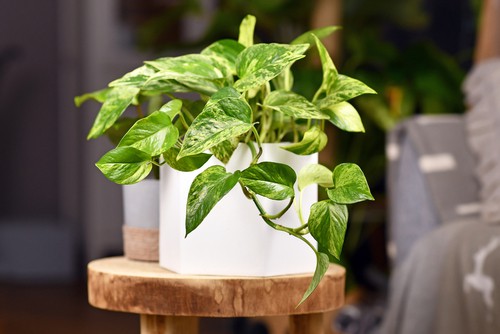Golden pothos are low-maintenance, easy to grow, and beautiful houseplants. Even in extreme conditions, the plant will always survive, which is how it got the name “devil’s ivy”. One of the many things people want to know before planting this plant is golden pothos growth rate?
Golden Pothos Growth Rate

Under the right conditions, golden pothos can grow up to 12 inches in a month during its growing season. If you provide the plant with enough light, water, and temperature, it can grow up to this size. In more suitable conditions, the golden pothos can grow up to 18 inches or more per month.
Perhaps your devil ivy plant is growing slowly, it means something is not right. Regardless, there are ways to make the plant thrive the way it is supposed to. In this article, we will provide tips on how to make your golden pothos grow faster.
Keep on reading!
How Do You Make the Golden Pothos Grow Fast?
All plants have specific requirements that will make them flourish at the right time. If your golden pothos is not growing fast, it means the plant is deficient in one or more areas.
Here are 6 factors you need to consider:
1. Water

As with other plants, pothos need water to survive. However, only water the plant when the soil feels dry to the touch.
By nature, pothos are tough plants, which means they can survive extreme conditions such as underwatering. Nevertheless, do not underwater the plant as this can result in dehydration.
On the other hand, overwatering can also expose the plant to fungal infections, or worse, root rot. Ideally, you should water the pothos only once or twice a week.
2. Light
If your pothos is indoors, keep it in a place where it can receive bright, indirect sunlight every day. Consider placing the plant near the window or in a sunny room where curtains form a shade.
In a situation where there’s not enough sun for the plants, use artificial light. Just make sure the plant is exposed to at least 10 hours of bright, indirect light every day. This will make the plant grow healthily and speedily.
3. Temperature and Humidity
Temperature and humidity are other factors that will determine how fast golden pothos will grow. If the plants are in places with temperatures below 50° F, they may struggle to grow. Always keep them in rooms with temperatures between 70 and 90° F.
Even though the golden pothos are hardy, they prefer high humidity. While the plants can tolerate low humidity, they may suffer in the long run. If you notice that the pothos leaves are turning yellow, the temperature or humidity in the environment might not be favorable.
4. Soil

Golden pothos flourish in a well-draining soil with good aeration. Compact soil can make the plant roots get too wet, which may cause root rot.
Any good soil for household plants is perfect for the pothos to grow well. You can also get regular soil and mix it with perlite, peat moss, or vermiculite to improve its drainage and aeration.
They also do well in soil that is rich in organic matter and has a PH that ranges from 6.1 to 6.5 on the scale. Avoid growing the plant in an old potting mix to see amazing results.
5. Nutrient
During their growing season, the golden pothos need the right amount of nutrients to grow well. Fortunately, the plants are not heavy feeders, but some potting soils lack essential nutrients that can benefit them. Fertilize the plant with a water-soluble organic solution every 2 to 3 months to improve its growth.
It’s not necessary to apply fertilizer to the golden pothos during winter. In addition, read the instructions on the fertilizer label before applying them to your pothos.
6. Pests

Always check for pests such as mealybugs, scale insects, spider mites, and aphids on your pothos as many times as possible. No matter the effort you invest in your plant, pests can limit its growth. And it is always better to get rid of these insects quickly before they take over the plants.
If there are pests on the plant, wipe it with a cloth soaked in alcohol. In a situation where the pest infestation on your golden pothos is serious, apply pesticides to the plant.
More on the pothos plant: Why Is My Pothos Droopy?
Conclusion
We’re sure you now know how fast golden pothos grow and what to do to make your plant thrive.
Golden pothos are one of the most popular house plants because they are easy to care for. Besides, these plants can survive extreme conditions and also add beauty to your home or office environment.
Nevertheless, you need to provide them with the right conditions to grow happily and healthily.
Frequently Asked Questions
Are Golden pothos Slow-growing?
No, golden pothos are not slow-growing plants. When the environment is favorable, these plants can grow between 18 to 24 inches in a month. But when you plant the pothos indoors, and they lack the necessary requirements, their growth can be slow.
Some things that can stop the golden pothos from growing are too much light, too much water, not enough nutrients, and low humidity.
Which Type of Pothos Grows Fastest?
Golden pothos, also known as the devil’s ivy, are the fastest-growing pothos. In favorable conditions, these plants can grow 20 to 40 feet tall and 3 to 6 feet wide.
Moreover, the golden pothos can grow as fast as 12 to 18 inches in a month with the necessary requirements.
In addition, the devil ivy is easy to maintain and, hence, good for beginners. Other varieties of pothos that grow fast include Jessinia (Epipremnum ‘Jessenia’) and Marble Queen.
Can You Plant 2 Different Pothos Together?
Yes, you can grow two varieties of pothos together without any problems. In fact, you can plant three or more pothos varieties in a single pot. But make sure the pot you’re using for growing the plants is large enough to contain them.
If the pot is too small, the plants may have to compete for nutrients. Besides, the plants will probably suffer from root rot and die.

Hey, I’m Lisa and I’ve been an avid gardener for over 30 years. I love writing, talking and living in the garden! Feel free to connect with me on my socials below

